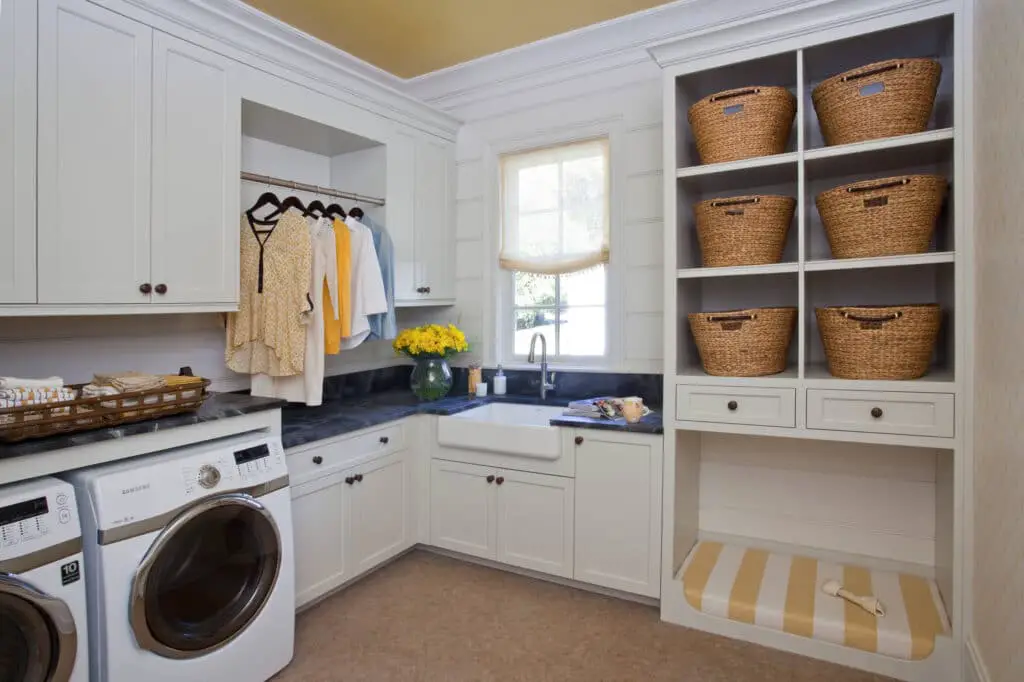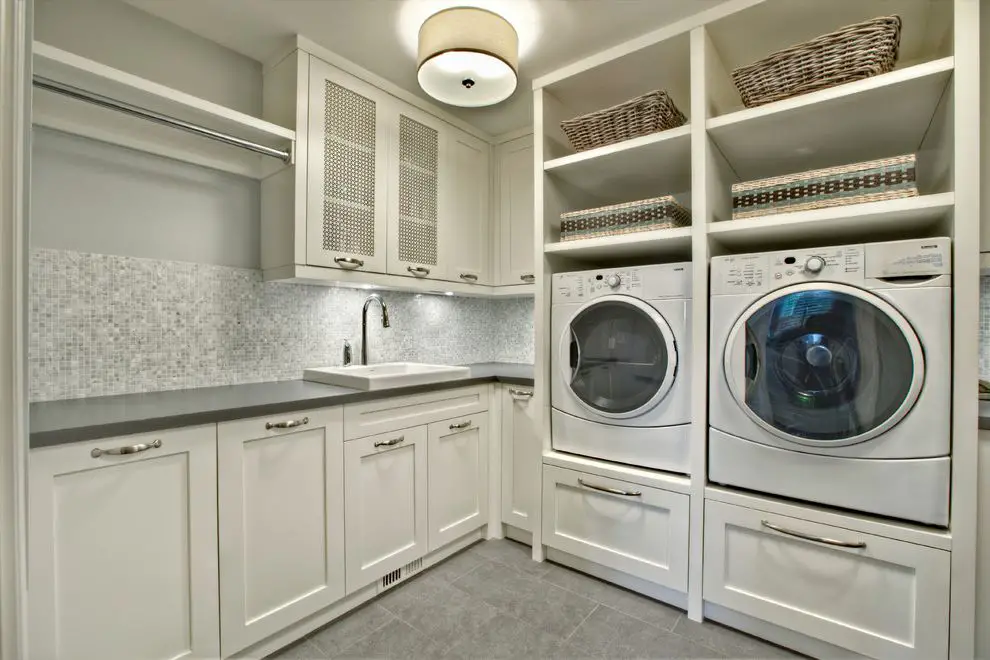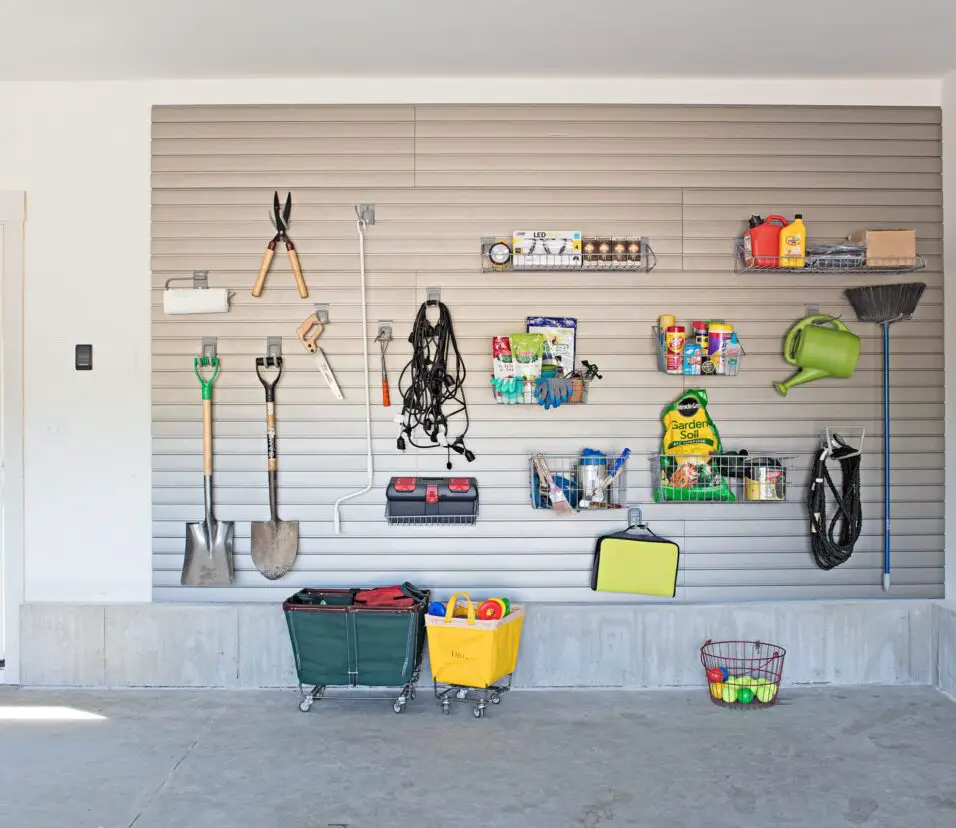How To Install Wall Cabinets In Laundry Room
Introduction
How To Install Wall Cabinets In Laundry Room: Before beginning the installation, make sure you have all the required tools and materials. These typically include a stud finder, level, measuring tape, pencil, screws, a power drill, a screwdriver, anchors (if needed), and of course, the wall cabinets themselves. Ensure the walls are clean and free from any obstructions. If there are existing cabinets or shelving units, remove them carefully. Use a stud finder to locate the wall studs, as these are essential for supporting the weight of the cabinets.
Using your measurements and a level, mark the placement of the wall cabinets on the walls. Double-check your markings to ensure they are level and accurately positioned. To provide additional support for the cabinets, you can install a wooden cleat along the wall’s length where the cabinets will be placed. This step is especially helpful if the cabinets are heavy or if your wall studs are not ideally positioned.
With the cabinet markings in place, start by attaching the cabinets one at a time. Have a friend or family member living room assist you in holding the cabinets in position while you secure them to the wall. Use the appropriate screws and ensure they go into the wall studs for a secure fit. Check for levelness and make any necessary adjustments. If you’re installing multiple wall cabinets side by side, use clamps to hold them together securely while you screw them into the wall. This ensures they remain aligned and create a seamless appearance.

How high do you hang cabinets in laundry room?
The height of the upper cabinets will depend on your ceiling height and how far you can reach. Positioning them at least 18 inches (46 centimeters) above countertops is standard, while 24 to 42 inches (61 to 107 centimeters) in 6-inch (15-centimeter) increments commonly defines the height of the wall cabinet itself.
The primary consideration when determining cabinet height is the comfort and accessibility of the users. Standard cabinet height typically ranges from 12 to 18 inches above the countertop, allowing easy access to frequently used items like detergent, fabric softener, and cleaning supplies. This height ensures that you won’t strain your back or arms when reaching for these essentials during laundry chores.
Consider the Users’ Height
Tailoring the cabinet height to the users’ height is a wise approach. Taller individuals may opt for slightly higher cabinets to minimize bending, while shorter individuals might prefer lower cabinets for ease of reach. However, keep in mind that a height comfortable for most members of the household should be the priority.
Maintain a Functional Work Triangle
If you have additional countertops in your laundry room, such as a folding station or sink area, it’s essential to maintain a functional work triangle. The work triangle is a concept borrowed from kitchen design, and it involves keeping the sink, washer, and dryer within an easy and efficient distance from one another. In this case, hanging cabinets at a height that complements the countertop’s level will create a harmonious and functional layout.
Consider Room Layout and Wall Space
Laundry rooms come in various shapes and sizes, and the layout can affect the optimal cabinet height. In rooms with limited wall space, higher cabinets might be necessary to maximize storage. Conversely, if you have plenty of wall space but a low ceiling, hanging cabinets too high may make the room feel cramped and visually unbalanced.
What cabinets are best for laundry room?
Wall cabinets are the default type of cabinet for many laundry rooms since they use no floor space, plus they take advantage of the wasted wall space above the washer and dryer.
Wall-mounted cabinets are a popular choice for laundry rooms with limited floor space. They are installed above countertops, washers, or dryers, making use of vertical space efficiently. Wall cabinets come in various sizes, styles, and materials, allowing you to customize them to suit your needs and complement the room’s decor.
Base cabinets provide excellent storage for larger items and bulkier laundry supplies. They are typically installed on the floor and often come with shelves or drawers, making them ideal for storing laundry baskets, cleaning equipment, and other household items. If you have space available, combining base cabinets with wall-mounted ones can create a comprehensive storage solution.
Tall Utility Cabinets
Tall utility cabinets are perfect for laundry rooms that require extra storage space. These cabinets offer a vertical storage solution for brooms, mops, vacuum cleaners, and other tall items that need to be kept out of the way. They are versatile and can be integrated into various corners of the room.
Open Shelving
Open shelving is a trendy option for laundry rooms with a more contemporary or industrial design aesthetic. It provides a more accessible storage solution and allows you to display decorative items or frequently used supplies within easy reach. However, keep in mind that open shelves may require more organization to maintain a clutter-free look.
How deep are laundry room wall cabinets?
24 inches
Depth. Like kitchen cabinets, standard laundry room cabinets have a depth of 24 inches (61 centimeters) for the base and 12 inches (30 centimeters) for the upper. Widths.
The standard depth for most laundry room wall cabinets is 12 inches. This depth strikes a balance between providing ample storage space for laundry essentials and maintaining a streamlined appearance without protruding too much into the room. A 12-inch depth is typically sufficient for storing detergent bottles, fabric softeners, and other laundry supplies.
Assessing Available Space
Before finalizing the depth of your laundry room wall cabinets, assess the available space in your laundry room. Measure the wall where you intend to install the cabinets and consider any potential obstructions such as windows, doors, or appliances. If you have limited wall space, you may need to opt for a shallower depth to ensure the cabinets fit comfortably without impeding functionality.
Clearance and Accessibility
Another critical consideration is the clearance and accessibility around your laundry room wall cabinets. Make sure there is enough space between the cabinets and the countertop, washer, or dryer, allowing you to access the appliances easily. Additionally, if you plan to install base cabinets or utility cabinets below the wall cabinets, ensure they don’t interfere with each other.
Storage Requirements
Assess your laundry room’s storage requirements to determine the optimal cabinet depth. If you have larger items, such as irons, brooms, or cleaning supplies, consider deeper cabinets or a combination of shallow and deep cabinets to accommodate various items. Customizing cabinet depth based on your specific storage needs ensures a more organized and clutter-free laundry space.
Should laundry room cabinets go to the ceiling?
Installing DIY laundry cabinets that reach the ceiling is the best way to maximize your storage space. However, the cabinets don’t need to be this tall if it doesn’t suit your needs. If you have high ceilings or don’t want the cabinets that tall, you don’t have to have them go up that high.
Maximized Storage Space: The most apparent benefit of extending cabinets to the ceiling is the maximization of storage space. This option provides additional shelf space where you can store items that are not frequently used or seasonal belongings, reducing clutter in other areas of your home.
Aesthetic Appeal: Floor-to-ceiling cabinets create a visually pleasing and cohesive look, making the laundry room appear more organized and streamlined. The continuous flow of cabinets draws the eyes upward, giving the illusion of a taller and more spacious room.
Dust and Grime Prevention: By eliminating the gap between the top of the cabinets and the ceiling. You minimize the accumulation of dust and grime in hard-to-reach spaces. This feature results in less maintenance and makes cleaning more manageable.
Versatile Design Options: Floor-to-ceiling cabinets offer greater design flexibility, allowing you to customize the layout according to your storage needs. You can incorporate open shelves, pull-out drawers, or enclosed cabinets at various heights to accommodate different items.

Should I put cabinets in my laundry room?
Taking your cabinets vertically can increase the storage area in your laundry room significantly, especially if you’ve got high ceilings. We recommend adding cabinets higher up for over washer and dryer storage. These cabinets are the perfect place to store laundry detergents and cleaning supplies.
Ample Storage Space: One of the primary benefits of adding cabinets to your laundry room is the additional storage space they provide. Cabinets offer a convenient and organized way to store laundry essentials, cleaning supplies, and household items, reducing clutter and keeping the room tidy.
Enhanced Organization: With cabinets, you can easily categorize and store various items, making it easier to find what you need during laundry chores. Customizable shelving and drawers allow you to create a tailored storage solution that meets your specific needs.
Concealment of Clutter: Laundry rooms can quickly become cluttered with laundry supplies and other miscellaneous items. Cabinets offer a great solution to hide these items from view, creating a neater and more inviting space.
Increased Efficiency: Having a well-organized laundry room with cabinets ensures that everything you need is within easy reach. This can help streamline your laundry routine and make tasks more efficient.
Aesthetics and Design: Cabinets can add a touch of style and elegance to your laundry room. They come in various designs, finishes, and hardware options, allowing you to match the cabinets to your preferred aesthetic and complement the overall decor of your home.
Potential for Multi-Functional Use: Laundry room cabinets can serve purposes beyond just storing laundry supplies. They can be used for additional household storage, like keeping tools or seasonal items out of the way.
How do I style my laundry room?
Bright paint or wallpaper can help make chores pleasant, while fun signs, posters, murals and wall decals can enhance laundry room designs of all styles. Think of your storage containers as laundry room decor too; find bins, baskets and hangers with fun patterns and colorful fabrics to bring life to the space.
Introduce patterns and textures through wallpaper, tiles, or textiles to add visual interest to the space. Consider patterned wallpaper or a patterned backsplash behind the sink or washer/dryer area. Textured elements like wicker baskets or textured wall art can also enhance the overall design.
Invest in functional storage solutions to keep your laundry room organized and clutter-free. Install wall-mounted cabinets, shelves, or floating shelves to store laundry supplies, cleaning products, and other essentials. Utilize baskets, bins, or labeled jars to corral smaller items.
If space allows, consider adding a designated folding station with a countertop. This will provide a dedicated area for folding clothes, making the process more efficient and less chaotic.
Replace basic plastic laundry baskets with stylish options that complement your decor. Woven baskets, decorative hampers, or fabric-lined bins can add a touch of elegance to your laundry room while keeping dirty clothes out of sight.
Good lighting is essential in a laundry room. If natural light is limited, install bright overhead lighting or task lighting over the folding station and sink area. Proper lighting will make tasks easier and create a more inviting atmosphere.
How much does it cost to put cabinets in a laundry room?
Cabinets. Cabinets are a great way to hide all of your laundry supplies, making your space look extremely organized (even if it’s just hiding organized chaos). The cost of installing cabinets in your laundry room can vary from $250 to $2,000.
The type of cabinets you choose will have a significant impact on the overall cost. Stock cabinets are the most budget-friendly option, as they come pre-made in standard sizes and designs. Semi-custom cabinets offer more flexibility in terms of size, materials, and finishes, but they are generally more expensive than stock cabinets. Custom cabinets provide the highest level of personalization. Can be the most expensive option due to the bespoke nature of the design.
The material used for the cabinets and the type of finish will affect the cost. Basic materials like laminate or melamine are more affordable, while solid wood or high-quality veneers can increase the price. Additionally, special finishes or custom paint colors may add to the overall cost.
The number of cabinets and their size will impact the total cost. Larger laundry rooms with more cabinets will naturally cost more to outfit than smaller spaces. Also, complex layouts that require additional customization. Unique cabinet configurations may lead to higher costs.
Hardware such as handles, knobs, and hinges can contribute to the overall cost. Upscale or decorative hardware options will increase expenses. Additionally, accessories like pull-out drawers, built-in laundry hampers, and internal organizers may add to the cost, but they can enhance the functionality of the cabinets.
Labor costs, including installation, can vary depending on the complexity of the job and the location of your laundry room. If you are hiring professional installers, the installation fees will be an additional cost to consider. DIY installation is an option to save on labor costs, but it requires the necessary skills and tools.
How much space is needed for a laundry room?
In all, you’re looking at needing 8-12 feet of wall space where you’ll place your washer and dryer. Now that you’ve laid out the length of the room, let’s talk about width. You’ll need at least 42 inches of space between the front of your washer and dryer and the wall or cabinets on the other side of the room.
The primary consideration in a laundry room is accommodating the washer and dryer. Standard washing machines and dryers typically require an area with dimensions of around 27 to 30 inches in width and 30 to 35 inches in depth. Front-loading machines may require more depth to accommodate the door swing.
Ensure you have adequate space around the appliances for loading and unloading clothes. Leave at least 42 to 48 inches in front of the appliances to provide comfortable access. Additionally, leave some clearance space behind the machines for easy maintenance and venting requirements.
If space allows, adding a countertop above the washer and dryer provides a convenient folding and sorting area. A minimum depth of 18 to 24 inches is recommended for a functional workspace. Consider extending the countertop above the appliances. To create a cohesive and seamless look.
Incorporate storage solutions that meet your needs. Wall-mounted cabinets or open shelves provide vertical storage for laundry supplies and cleaning products. Consider using the vertical space up to the ceiling to maximize storage capacity.
If you desire a utility sink for handwashing or other tasks, allocate enough space for it. A sink typically requires a minimum of 24 inches in width and 18 to 24 inches in depth. Ensure there is space around the sink for comfortable use.

Conclusion
Remember, safety should always be a priority during any home improvement project. Take your time, use the right tools, and seek assistance if needed, especially when working with power tools or at heights. With your new wall cabinets securely in place, you can now efficiently store laundry supplies, cleaning products, and other essentials, keeping them within easy reach whenever you need them. The cabinets will also help to keep the room tidy and reduce visual clutter, making laundry time a more enjoyable and efficient experience.
As you revel in your newly improved laundry room, take a moment to appreciate the hard work and effort you’ve put into this project. You’ve not only added value to your home but have also honed your DIY skills, gaining confidence for future projects. Lastly, always remember to maintain wall cabinet and care for your cabinets regularly. Keep them clean and check for any signs of wear or loose hardware.
With proper care, your wall cabinets will serve you well for many years to come. Now that you’ve mastered the art of installing wall cabinets, you might find yourself exploring other home improvement projects to further enhance your living space. Whether it’s renovating other areas of your home or tackling smaller projects, your newfound skills will undoubtedly come in handy.





